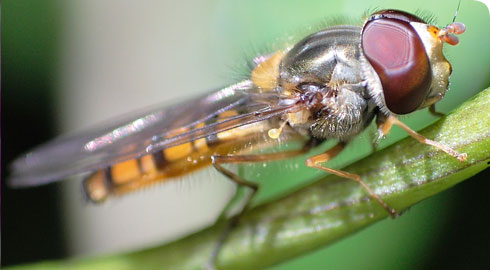Biology
Like most other hoverflies, the adult E. balteatus are flower feeders and feed on nectar and pollen. They are beneficial to agriculture as important flower pollinators.
The males establish territories. They mark their territories by hovering over the area - often in a shaft of sunlight in open woodland - to attract females and chase off rival males.
After mating, females lay their eggs on foliage close to aphid colonies, or sometimes speculatively on plants that have yet to be colonised by aphids. The larvae are aphid predators and are mainly active at night.
In the UK, they have been shown to be important biological control agents of aphids on cereal crops.
Like other predatory fly larvae, they are occasionally cannibalistic, feeding on younger, smaller larvae of their own species.
The larvae are typical in structure for aphid-feeding hoverflies:
- they are dorso-ventrally flattened with no legs
- the posterior spiracles are on a short respiratory tube
- they are headless with their mouth-hooks attached to a cephalo-pharyngeal skeleton
They feed by grabbing and piercing their prey using the mouth-hooks and sucking out the aphid’s body contents before discarding its empty skin.
Each larva consumes more than 200 aphids during its development.
Larvae are whitish and semi-translucent - internal structures such as white fat bodies, orange tubules and dark gut contents are clearly visible.
Life cycle
When the larva is ready to pupate, its skin hardens to provide a protective case - or puparium - for the fragile pupa inside.
Pupation occurs near aphid colonies and the life cycle is completed within a month.
There are sometimes two generations of fly per year in the UK - one in late spring, the other from mid-summer to early autumn.
The spring generation is thought to arise from overwintering adults, and may be absent following a cold winter.
